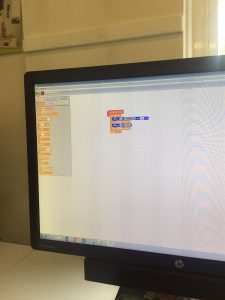Exploring Crumble Boards and Introduction to Project
Within the first session of connecting worlds the group explored the technology of crumble boards. The crumble boards we explored used the equipment of crocodile clips with red, black and green wires, batteries, LED lights and the electric board. Once all the equipment was connected together (picture 1), I connected the board to the computer to programme the LED lights to switch on in a variety of ways. The programme used was very similar to Scratch (picture 2), so by using this programme in school, if the children are familiar with Scratch, it would be a good opportunity to visually see how programming works in a real life situation through the lighting up of the LED lights (picture 3). In my opinion, this is a much better way of programming for the children as it is more straight forward than Scratch and there a many ways the LED lights can be programmed compared to the use of Scratch. Crumble boards also linked more closely to the National Curriculum as it states children should be taught to ‘design, write and debug programmes that accomplish specific goals, including or simulating physical systems’ (DfE, 2013). By children using the crumble boards within their computing lessons, allows for them to explore this specific part of the curriculum through them controlling the LED lights and other components such as buzzers, if added.
During the next part the session, the group were introduced to their project and year group we would be completing our work in. The group I would be completing the project in is year 3 and the focus would be on textiles and LED lights. This meant that despite exploring crumble boards within the first part of the lesson and seeing the positives of using the equipment in teaching computing, it was apparent that we could not use them within our project. We had to focus our computing aspect of the project around 2D design and the use of LED light circuits.
Once the projects had been revealed, our group, which consisted of myself and two other people, discussed what we could base our project around. As a non-DT specialist and being placed with two DT specialist, I did at the start find it quite difficult to get my ideas across as I felt the others would have better and more experience within the area. But the more we discussed ideas, my confidence grew in my own ideas and the final project agreed was all our ideas put together. As a group we decided to focus our project on the idea of different background scenes and the children would create a character for their scene. The LED lights would then be placed within the character, for example their eyes to ensure the computing aspect was included. It was decided that each class would be given four different scenes (underwater, haunted house, rainforest and skyscrapers) and they would design their backgrounds in the class and our group would create these backgrounds prior to re-visiting the classes again. When back in school, the children would create their characters with us in pairs.


